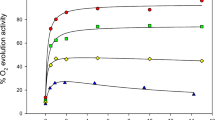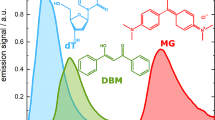Summary
Light induced the formation of an energy pool in chloroplast fragments which was emptied within 20–30 min in the dark, while an ATP-Pi exchange was going on.
The exchange reaction was dependent on Mg2+ and was inhibited by NH +4 but not by ADP. The optimum pH in the light and in the dark stage of the reaction lay between pH 7.5 and 8.
The high energy intermediate was formed only in the presence of DTT in the light stage; phosphate had no influence on the formation of the intermediate in that period, but increased its stability in the dark.
The relation between both high energy intermediates, that of the light-induced ATP-Pi exchange reaction and that of the light-induced ATP synthesis, is discussed in its meaning for the hypothesis of chemiosmotic phosphorylation.
Zusammenfassung
Bei Belichtung bildet sich in Chloroplasten ein „Energie-pool”, der im Dunkeln innerhalb von 20–30 min wieder geleert wird. Dabei kann ein Austausch zwischen ATP und anorganischem Phosphat stattfinden. Die Austauschreaktion ist abhängig von Mg2+ und durch ADP nicht hemmbar; dagegen blockieren NH +4 -Ionen. Optimaler pH-Wert in Licht- und Dunkelphase ist pH 7,5–8.
Der energiereiche Zwischenzustand bildet sich nur bei Anwesenheit von DTT im Licht; Zugabe von Phosphat im Licht hat keinen Einfluß auf seine Entstehung, erhöht jedoch seine Stabilität im Dunkln. Es wird diskutiert, wie sich die energiereichen Zwischenzustände bei der lichtinduzierten ATP-Pa-Austauschreaktion und bei der lichtinduzierten ATP-Synthese zueinander verhalten im Hinblick auf deren Bedeutung für die chemiosmotische Phosphorylierungshypothese.
Similar content being viewed by others
Literatur
Arnon, D.I.: Copper enzymes in isolated chloroplasts. Polyphenoloxydase in Beta vulgaris. Plant Physiol. 24, 1 (1949).
Avron, M.: Photophosphorylation by Swiss-chard chloroplasts. Biochim. biophys. Acta (Amst.) 40, 257 (1960).
Bachofen, R., u. I. Specht-Jürgensen: Durch Säure-Base-Übergang induzierte ATP-Pa-Austauschreaktion in Chloroplasten. Z. Naturforsch. 22b, 1051 (1967).
Bennun, A., and M. Avron: Light-dependant and light-triggered adenosinetriphosphatases in chloroplasts. Biochim. biophys. Acta (Amst.) 79, 646 (1964).
Carmeli, C., and M. Avron: Light-triggered ATP-Pi exchange activity in chloroplasts. Biochem. biophys. Res. Commun. 24, 923 (1966).
Gromet-Elhanan, Z., and M. Avron: Effect of inhibitors and uncouplers on the separate light and dark reactions in photophosphorylation. Plant Physiol. 40, 1053 (1965).
Hind, G., and A. T. Jagendorf: Separation of light and dark stages in photophosphorylation. Proc. nat. Acad. Sci. (Wash.) 49, 715 (1963).
——: Light scattering changes associated with the production of a possible intermediate in photophosphorylation. J. biol. Chem. 240, 3195 (1965a).
——: Effect of uncouplers on the conformational and high energy states of chloroplasts. J. biol. Chem. 240, 3202 (1965b).
Hoch, G., and J. Martin: Photo-potentiation of adenosine triphosphate hydrolysis. Biochem. biophys. Res. Commun. 12, 223 (1963).
Jagendorf, A. T., and E. Uribe: ATP formation caused by acid-base transition of spinach chloroplasts. Proc. nat. Acad. Sci. (Wash.) 55, 170 (1966).
Jagendorf, A. T., and E. Uribe:In: Energy conversion by the photosynthetic apparatus. Brookhaven Symposium 19, 215 (1967).
Kaplan, J., E. Uribe, and A. T. Jagendorf: ATP hydrolysis caused by acid-base transition of spinach chloroplasts. Arch. Biochem. 120, 365 (1967).
Marchant, R.H., and L. Packer: Light and dark stages in the hydrolysis of adenosine triphosphate by chloroplasts. Biochim. biophys. Acta (Amst.) 75, 458 (1963).
Mitchell, P.: Coupling of phosphorylation to electron and hydrogen transfer by a chemiosmotic type of mechanism. Nature (Lond.) 191, 4784 (1961).
—: Chemiosmotic coupling in oxydative and photosynthetic phosphorylation. Biol. Rev. 41, 445 (1966).
Packer, L., and R. Marchant: Action of adenosine triphosphate on chloroplast structure. J. biol. Chem. 239, 2061 (1964).
Petrack, B., A. Craston, F. Sheppy, and F. Farron: Studies on the hydrolysis of adenosine triphosphate by spinach chloroplasts. J. biol. Chem. 240, 906 (1965).
—, and F. Lipman: Photophosphorylation and photohydrolysis in cell-free preparations of blue-green alga. In: Light and life (W. D. McElroy and B. Glass, ed.), p. 621. Baltimore: The Johns Hopkins Press 1961.
Racker, E.: Mechanism in bioenergetics. New York and London: Academic Press 1965.
Shen, Y. K., and G. M. Shen: Studies on photophosphorylation. II. The “light intensity effect” and intermediate steps of photophosphorylation. Scientia Sinica (Peking) 11, 1097 (1962).
Whatley, F. R., and D. I. Arnon: Photosynthetic phosphorylation in plants. In: Methods in enzymology, vol. VI (S. P. Colowick and N. O. Kaplan, ed.) p. 308. New York: Academic Press 1963.
Author information
Authors and Affiliations
Rights and permissions
About this article
Cite this article
Specht-Jürgensen, I., Bachofen, R. Untersuchungen zur lichtinduzierten ATP-Pa-Austauschreaktion in Spinatchloroplasten. Planta 79, 222–234 (1968). https://doi.org/10.1007/BF00396029
Received:
Issue Date:
DOI: https://doi.org/10.1007/BF00396029




